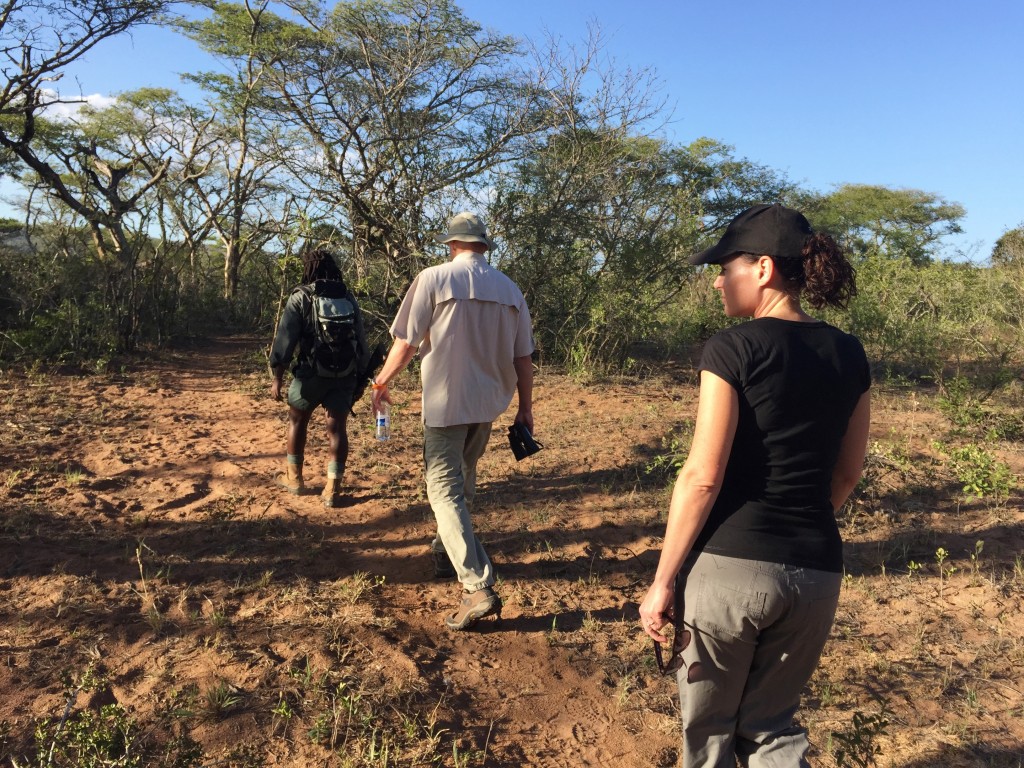Rhino Whisperer
Posted in:Experiences | Rhino Ridge Safari Lodge | Wildlife
Posted on:April 16, 2016
Nothing can quite prepare you for the experience of walking in the wilds of a game reserve in Africa. And Hluhluwe-iMfolozi is no theme park – this is the real thing, a vast safari park with untamed lion, leopard, elephant, buffalo and one of the highest concentration of rhino of all wildlife parks in the world.
I have found that one’s experience of such a walking safari rests heavily on the competence and safety of one’s guide. An encounter with one of the great beasts of Africa can quickly go from thrilling to frightening. So it is with great enthusiasm that I hear that the newly introduced walking trails from Rhino Ridge Safari Lodge are led by none other than Nunu Jobe. A legend in his own right, he has worked as a Wilderness Trails Guide in the iMfolozi Game Reserve for many years and is best known for his uncanny ability of getting within metres of a white rhino with safety and respect. Our very own “Rhino Whisperer”.
The bush walks from Rhino Post Safari Lodge are usually conducted in the ‘Big 5’ concentrated area of Hluhluwe-iMfolozi. Children of 14 years and upwards may walk, but need to be accompanied by a supervising adult. Young people 16 years and older may walk unaccompanied. We may take 4 guests per armed and accredited guide (accredited by Ezemvelo KZN Wildlife) and would ideally conduct walks of 8 people, ensuring each lead guide then has armed backup.
Rhino Ridge Safari Lodge also offers “Gorge Walks” which are suitable for families with kids strong enough to walk back up the steep hill – the guideline is 8 years old and upwards. On this walk guests can explore the magnificent riverine gorge area below the camp with its exquisite bird life and flora.
Walks are typically 2 – 3 hours long and guests stop for a refreshment break along the way. The cost of a Big 5 walk is R490 (incl VAT) and R300 for the Gorge Walk. To book a walk at Rhino Ridge Safari Lodge, click on this link. To learn more about the safety and practicalities of such an experience, you may also like to read about similar Rhino Walking Safaris which take place at our sister lodge in the Kruger National Park.

“What a place this Hulhluwe-iMfolozi” reflects Nunu Jone, “primitive.”
Here is some practical information about what to expect on a walking safari, written by Characterstays and published by Isibindi Africa on Africa Geographic:
- How real is it?
Very – this is no joke and it is an authentic walking safari in the open bushveld of Africa. These are wild animals, not tame ones, and they are focused on their survival.
- How dangerous is it?
Your safety rests in the experience of your guides. The Isibindi guides are highly experienced, extremely well qualified nature guides, with a specialist additional qualification in leading walking safaris. They take seriously the guests’ wish to encounter game, but this is always preceded by concerns for safety. Think about it – their livelihood is at stake and they would lose everything if a guest was injured. And we would all hear about it from Timbitene to Timbucktoo.
- How does it work?
We walk in single file, in silence, behind the armed guide and armed tracker. Only if the guides deem it safe enough do we break single file and discuss what we see.
- What should we wear?
We start out early in the morning, while the veld is still cool. But it is good to wear light layers, as already by 9am the sun can be warm in summer. Wear a hat or cap. Good walking shoes are helpful, but the terrain is not difficult and you can easily walk in open, flat sandals. (But maybe leave the Jimmy Choos for another lodge unless you are a hardened fashion safari guru).
- How long do we walk?
That is up to you and your guide will ask you the night before what you would prefer. Usually the walking safaris take about 3 hours, but you can request a shorter or longer walk if you like. We choose 2 hours for our first walk, then get braver and ask for 3 hours the next morning.
- What should we bring with us?
Only a camera, binoculars and a hat. Everything else, including water, juice and snacks, is provided.
- Which animals are the most scary to encounter?
Black rhino (which are very rare and keep to the thickets and have not been seen in the Timbitene Plains, which are more open), lion, buffalo and hippo. Injured animals and mothers with babies can be more aggressive than usual.
- Will animals attack us if they notice us?
This is very unlikely. Animals (even the king of the beasts, lions) recognise humans as the top of the food chain. Therefore they will always prefer to avoid conflict. They will more likely run away if they become aware of your presence. It is usually only if you give them a fright and they feel cornered that they will attack. Even then they will give warning signs and usually do several mock charges to try to scare you off, and it would take a lot to provoke them into attacking you. The guides keep to open plains where there is good visibility and where it is unlikely that you will surprise an animal – the challenge is more to try to get closer to them without them running off.
9. What should we do if an animal charges us?
The most difficult thing – nothing. Stand still and do not run. If you run you lose your status on the top of the food chain and become prey. Most animals (even Black Rhino) will be put off by an animal, especially a group of animals, which stand their ground. They will also be put off by noise. The experienced guides will make a noise and if necessary, will discharge their weapons.
10. Could I be responsible for an animal being shot?
This is extremely unlikely. Once again, the aim is to avoid conflict, and the experienced guides wish for us all to appreciate nature from a safe distance.
To book a walking safari from Rhino Ridge Safari Lodge in Hluhluwe-iMfolozi, click on this link: Reservations

A guided walk is an enjoyable experience and you will soon find yourself trusting this experienced guide







